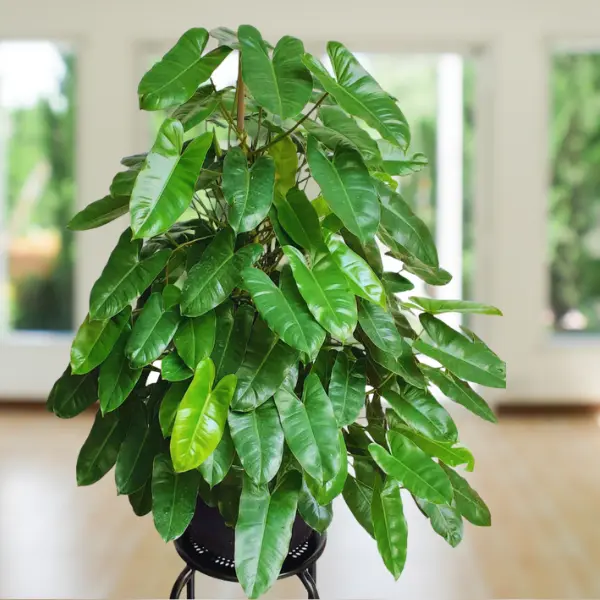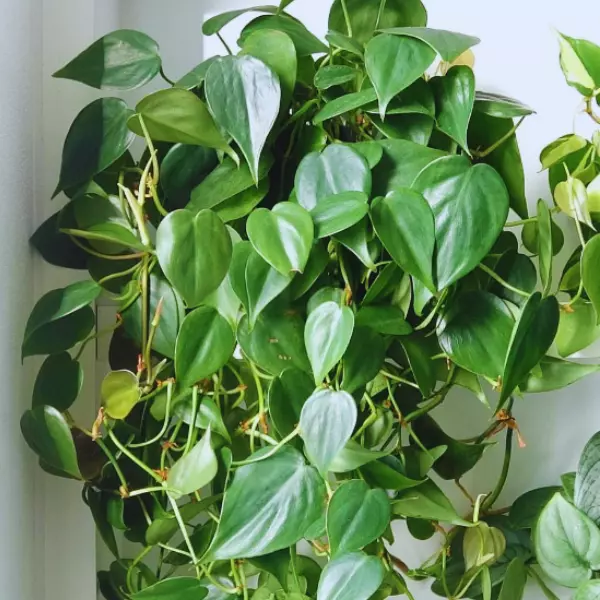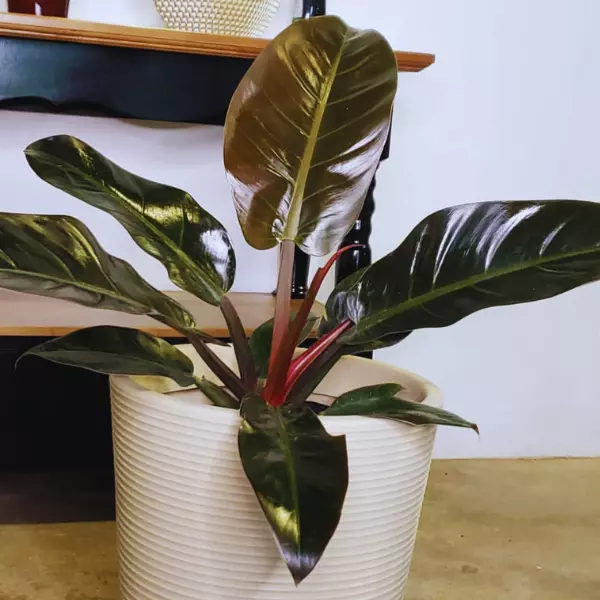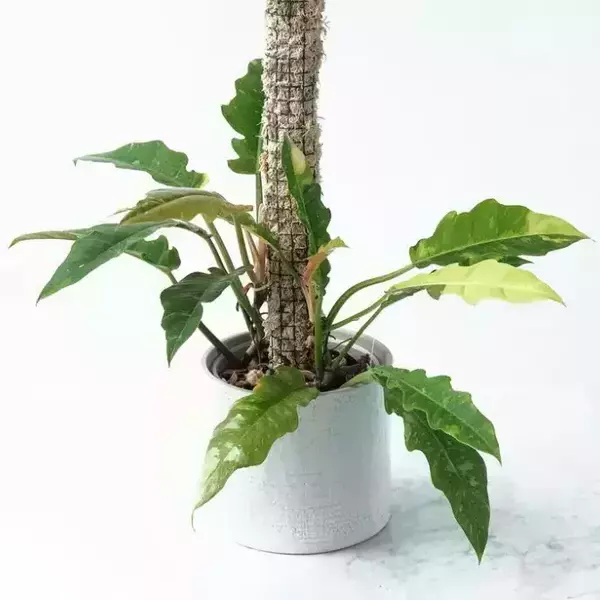This exquisite tropical plant gracefully serves as both a cascading or an ascending green presence. Distinguished by its heart-shaped foliage, Philodendron Brandi boasts lush olive-green leaves adorned with captivating silver and white accents, earning it its distinctive name.
Hailing from the lush landscapes of Brazil and Colombia, the Philodendron Brandtianum, also known as the Silver Leaf Philodendron, is an enchanting climbing species characterized by its petite medium to large heart-shaped leaves lavishly adorned with substantial white to silver pattern. It effortlessly lends itself to hanging baskets or terrariums, gracing any setting with its charming olive-green foliage highlighted by glistening silver or white accents.
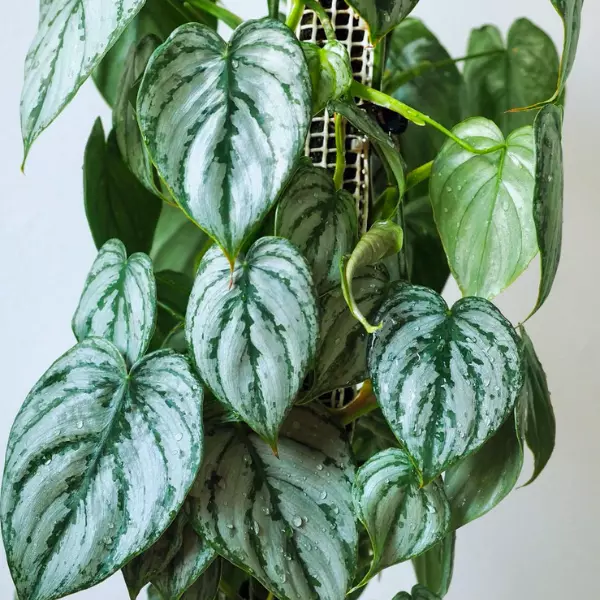
Philodendrons, renowned for their exceptional air-purifying abilities, meticulously cleanse their surroundings of noxious pollutants and chemicals such as formaldehyde. Within the illustrious Philodendron genus, they are celebrated as ‘the easiest to cultivate and most resilient to adversity.’ This feature makes the Philodendron Brandi an ideal choice for novices or individuals seeking to infuse their living spaces with greenery without excessive upkeep.
Closely-Related Allied Species: Philodendron Lemon Lime, Philodendron White Knight, Philodendron White Princess, Philodendron Florida Ghost, Philodendron Verrucosum, Philodendron Squamiferum , Philodendron Splendid
Essential Products
Origin and Family
Philodendron Brandtianum is a cascading/climbing plan of the Araceae family and is native to the tropical regions of South America.
| Botanical Name: | Philodendron Brandtianum |
| Family Name: | Araceae |
| Other names: | Silver leaf philodendron, philodendron brandi |
| Plant Type: | cascading/climbing perennial |
| Size | 15 ft. (outdoors), 4-5 ft. (indoors) |
| Origin: | South America |
| Color: | Dark green with silver Variegation |
| Leaf Shape | Heart-shaped leaves |
| Humidity: | 50% |
| Temperature: | 65°F to 80°F (18°C to 32°C) |
| Light Need | Bright Indirect light |
| Propagation | Stem cutting |
| Soil type | Well-drained organic soil |
| Pests | Mealybugs, Aphids, and Spider Mites |
How do you care for a Philodendron Brandtianum?
Philodendron Brandtianum is an ideal choice for newcomers to the Philodendron family, as this plant is renowned for its ease of care. To ensure that your lovely Philodendron thrives, it’s vital to consider specific care guidelines.
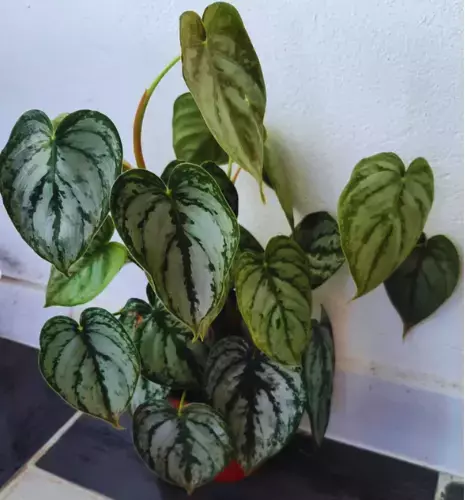
Firstly, selecting the right soil is crucial, therefore opt for nutrient-rich, well-draining soil, providing an ideal foundation for your plant’s flourishing growth. Secondly, the plant’s ideal lighting conditions, hence place it in a location with bright, indirect light, allowing the plant to bask in sufficient sunlight without direct exposure.
When it comes to watering, consistency is key, thus maintain a regular watering routine, ensuring the top layer of soil dries out before you water deeply. This practice not only promotes robust root development but also prevents the risk of overhydration. Additionally, during the spring and summer months, consider fertilizing your Philodendron Brandtianum if desired. This seasonal nourishment can significantly enhance its growth and overall vitality, contributing to a vibrant and healthy plant.
With these care requirements, you can nurture a thriving Philodendron Brandtianum that not only graces your living space with its beauty but also contributes to a healthier indoor environment.

Philodendron Brandi Growth
Philodendron Brandtianum is a moderately fast-growing climbing vine featuring medium to large heart-shaped leaves exhibiting white to silver variegation. When mimicking its natural tropical climate, the plant will reach a total height of 4 to 5 feet when grown as a houseplant.
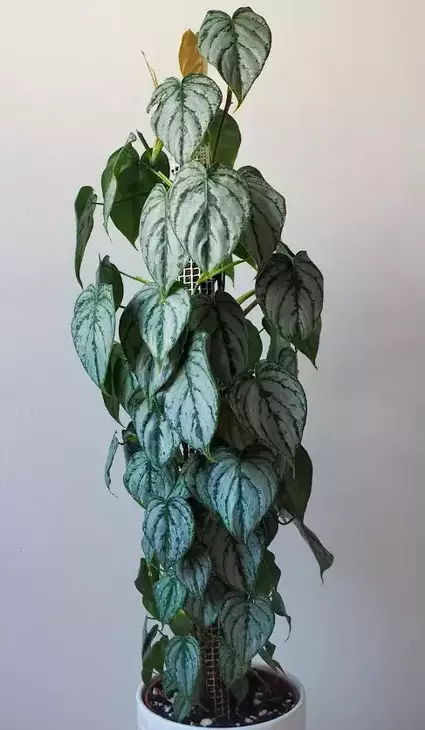
However, in its natural habitat it can grow up to 15 feet. Moreover, the size of the leaves will be huge if Brandtianum is mounted to a moss pole compared to the one potted as a hanging plant.

Light Needs
In its natural habitat within the lush tropical rainforests of Brazil, Philodendron Brandtianum flourishes beneath the canopy, basking in bright yet filtered sunlight. It is essential to provide bright, indirect light to replicate Brandi’s natural habitat at home. This entails positioning the plant in an area where it can enjoy consistent, gentle illumination without being exposed to direct and harsh sunlight.
A unique trait of silver leaf philodendron is its adaptability to low-light environments. Although it thrives in indirect light, it can endure brief periods of direct sunlight. However, it’s imperative to shield it from prolonged exposure to intense sunlight, particularly during the midday hours when the sun’s rays are at their most potent.
When selecting an indoor spot for your Philodendron Brandtianum, prioritize locations with bright, filtered light sources. Ideal options include areas near east or north-facing windows, where the plant can receive the gentle morning sunlight. In cases where natural light is limited, fluorescent grow lights suspended a few feet above the plant can serve as effective artificial lighting alternatives.
But that’s not enough; you should always be vigilant and look for the signs and symptoms of light-related issues such as yellow, leggy or burnt leaves and slow or dormant growth. In case of any such sign, fix the lighting conditions for this plant to keep thriving.

Temperature and Humidity
The stunning silver leaf philodendron requires not only proper lighting but also specific environmental conditions to thrive, such as high humidity and moderate temperatures. These two factors play a crucial role in the optimal growth and well-being of this lovely plant.
This tropical beauty hails from the humid rainforests of Brazil, making high humidity levels a vital factor in its care. Ideally, the humidity level around your Brandtianum should be around 50%. To maintain high humidity, use a tray filled with water and pebbles to place it near the plant. If you notice symptoms of low humidity, such as brown leaf tips, leaf curling and slow growth, please move your plant to a high humidity level area such as the kitchen or bathroom.
To boost humidity, besides misting and humidity trays, consider using a humidifier in the room where the plant resides. Grouping houseplants can also create a microclimate with higher humidity. Remember, maintaining the right humidity is key to your thriving Philodendron Brandtianum.
As far as the temperature is concerned, Philodendron Brandtianum thrives in temperatures between 65°F to 90°F. It is essential to avoid extreme temperatures to ensure your plant’s good health.
Exposing your Philodendron Brandi to temperatures below 50°F (10°C) can be detrimental. Cold drafts or sudden temperature drops can lead to slowed growth and even leaf damage. On the other hand, excessively high temperatures, especially above 90°F (32°C), can cause stress and negatively impact the plant’s health.
Also, this plant is sensitive to sudden temperature swings, such as placing the plant too close to a heater or air conditioner, which can stress the plant and lead to issues like leaf yellowing or curling.

Watering
Silver Leaf Philodendron is a beautiful and popular houseplant appreciated for its striking foliage. It’s essential to provide it with the right amount of water to keep this tropical beauty thriving.
During the summer, when the plant is actively growing, it prefers moderately moist soil. Therefore, water it thoroughly when the top inch of the soil feels dry to the touch. Also, ensure that the pot has proper drainage to prevent waterlogging, as this plant does not tolerate sitting in water. Watering once a week should suffice in the summer.
In contrast, during the dormant period in winter, the watering frequency should be reduced. Since the plant’s growth slows down, it requires less water. In winter, it’s recommended to water the plant every 2-3 weeks.
Silver leaf Philodendrons are mostly sensitive to over or under-watering. Overwatering is a common mistake when caring for Philodendron Brandtianum. Signs of overwatering include yellowing leaves, wilting, and soil that remains consistently soggy. If left unaddressed, overwatering can lead to root rot, which can be fatal for the plant.
On the other hand, underwatering can also harm your plant. Symptoms of underwatering include dry, brown leaf edges, drooping, and slower growth. If you consistently underwater your plant, it may become stressed and more susceptible to pests.
Philodendron Brandtianum is relatively forgiving when it comes to water quality. Still, it does appreciate water that is free from chlorine and other chemicals. If you’re using tap water, you can let it sit out overnight to allow chlorine to dissipate, or use filtered water. Additionally, ensure that the water you use is at room temperature; cold water can shock the plant’s roots.
How to Determine soil Moisture?
Best watering technique is to let the topsoil dry between the watering sessions. The ideal method to determine the dry soil is to dip fingers in it and check the moisture. Using a moisture meter or moisture sensor is quite helpful in examining soil desiccation if you are not sure. Once the top soil dries, water your plant thoroughly, and wait until the excess water drains out from the drainage holes to prevent any root rot or fungal disease.

Bottom watering or using a self-watering pot for Philodendrons has been proven successful in my experience.

Soil Requirement
The right soil mix is crucial for the well-being of your Philodendron Brandtianum. It prefers well-draining soil that retains some moisture. Also, the ideal pH level for Brandi soil is slightly acidic, around 6.0 to 6.5. Maintaining the proper pH ensures the plant can access essential nutrients in the soil.
As discussed above, this plant loves slightly moist soil with proper drainage and aeration; therefore, it is preferred that you make your soil mix by mixing the following ingredients.
- House plant potting mix 25%
- Orchid bark 25%
- Perlite 25%
- Coco Coir or Peat Moss 15 %
- Worm castings 10% (add richness to the soil)
- Charcoal
Additionally, you can also find commercially available potting mixes specifically formulated for tropical houseplants like Philodendron Brandtianum. These are convenient options that often provide an ideal balance of ingredients.

Repotting Philodendron Brandi
Philodendron Brandtianum is a fast grower and typically needs repotting every 2-3 years or when it outgrows its current container. Signs that it’s time to repot include the roots becoming root-bound, slow growth, or the plant becoming unstable in its pot.
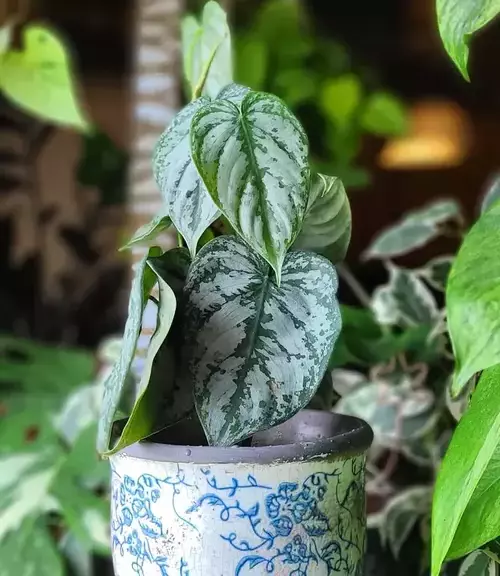
The best time to transplant the plant is in spring or summer as it’s a growth season and may help to adjust the plant to a new place.
Repotting Guide
Whenever you repot your plant, always follow the below-mentioned steps carefully to ensure your plant’s safety and successful repotting.

Fertilizing
The Brandtianum plant benefits from regular feeding during the growing season, typically spring through early autumn. However, during the dormant winter months, it requires less fertilizer.
Fertilize your plant every 4-6 weeks with a balanced, water-soluble fertilizer diluted to half the recommended strength. Avoid over-fertilizing, as this can lead to nutrient imbalances and damage the plant.
Choose a all-purpose liquid fertilizers with equal NPK (nitrogen, phosphorus, potassium) ratios. Apply the diluted fertilizer directly to the soil during watering to ensure the plant’s roots can access the nutrients.
Over-fertilization can result in excessive salt buildup in the soil, leading to root damage and nutrient imbalances. Signs of over-fertilization include brown leaf tips and yellowing leaves. Consequently, under-fertilization may cause slow growth and pale leaves. Finding the right balance is key to a healthy, flourishing plant.
If you are new to plant parenting I highly recommend trying Miracle-Grow Indoor Plant Food Spikes. These pellets are really easy to use and will not burn any foliage of your plant.
Here are some good fertilizers for on the market:

Philodendron Brandtianum Propagation
Since Philodendron Brandtianum is a vining philodendrons with lots of aerial roots and multiple growth points or nodes, it can easily be propagated via stem cuttings and air layering.
Stem Cutting Propagation
I prefer stem-cutting propagation for this cascading or climbing philodendron as this is simple and has a high success rate.
Follow a step-by-step guide for Philodendrons Brandtianum propagation via stem cutting.
Propagation in Water
For a cutting with very little roots, I usually put it in water because it does need to absorb more water to support the leaf and the new node from where new vine will appear.
Fill half a clean glass jar with distilled water and place the stem cuttings into the water, ensuring the bottom nodes of stem cuttings are entirely submerged. Keep your cuttings in a warm, humid place with medium indirect light. It is beneficial to change the water every few days until you notice enough roots (an inch or two long). Later you can transplant your cutting into the potting mix.
Propagation in Sphagnum Moss and Potting soil
You can also use sphagnum moss and aroid potting mix for rooting your cuttings. I prefer using sphagnum moss for cuttings that have a little bit of roots and potting mix directly if they already have a lot of roots.
Before putting your cuttings in sphagnum moss or potting mix, you might need to seal the edge of your cutting by applying cinnamon powder, anti-fungal powder, or activated charcoal to prevent rotting.
Choose a small plastic pot, put the Brandtianum’s cutting in it, and cover the node with a little potting mix. You don’t want to bury the node too much in the potting mix as it will increase the incidence of over-watering. Therefore, only put like half a pot of potting mix, and when the new vine comes up, you can always add more potting soil later.

Pruning and Maintenance
Philodendron Brandi is moderately growing plant; therefore, it doesn’t require frequent pruning. However occasional pruning encourages healthy growth by producing new leaves.
To encourage bushier growth, you can trim the infected, old, and damaged leaves. It’s essential to clean the dust on the leaves as it hinders transpiration and reduces photosynthesis; hence, clean the leaves regularly with a damp cloth. Regular cleaning also helps to keep an eye on potential pests and infections.
Moreover, you can propagate the cuttings and replant them in the pot to make the plant bushier.

Toxicity
The Philodendron Brandi contains calcium oxalate crystals, making it toxic to both humans and pets. Ingesting any part of the plant can lead to symptoms such as oral irritation, difficulty swallowing, and gastrointestinal upset. Therefore, keep it out of reach of curious children and pets, and seek medical attention if ingestion occurs.

Diseases & Pests
Though Philodendron Brandtianum is a relatively hardy plant, it can sometimes fall prey to common pests that can impact its health and appearance. Here are some potential pests that may affect this plant.
Aphids
These small, sap-sucking insects can cluster on the new growth of Philodendron Brandi, causing leaves to distort and yellow. To combat aphids, you can spray the plant with a mixture of water and a few drops of dish soap or neem oil. Ensure thorough coverage, including the undersides of leaves.
Scale insects
These tiny insects appear on the branches and stems of Philodendrons and are attached to those areas. They are harmful to the plant’s health and may cause by external factors such as dirty pots and contaminated potting mix.
To treat these insects, take a teaspoon of neem oil in 4 cups of water and spray it on the affected areas of the plant.
Cleaning leaves with a damp cloth every two weeks is very important to spot such issues.
Moreover, in case of spider mites and mealybugs attack, you can treat them with insecticidal soap spray.
Mealybugs
Mealybugs are notorious for congregating in the leaf axils and along the stems of philodendrons. They feed on plant juices, leading to wilting and yellowing of leaves. If you see white, brown, or cream fuzzy stuff on the plant leaves, it indicates your plant is infested with mealybugs. To treat this issue, wipe the leaves and other parts of the plant with a cotton swab dipped in rubbing alcohol.
Don’t forget to check the underside of the leaves as Mealybugs love to cluster there and usually go unnoticed by plant parents.
Spider Mites
These tiny arachnids are often indicated by the fine webbing they produce on leaves. They feed on plant juices, leading to stippled, discolored leaves. To manage spider mites, rinse the plant with a strong stream of water and apply insecticidal soap or neem oil to control the infestation.
Scales are typically immobile and appear as small, round, or oval bumps on the stems and leaves. They feed on plant sap, causing yellowing and a decline in plant health. You can remove scales by gently scraping them off with a soft brush or by applying neem oil.
Scale Insects
To prevent pest infestations in the first place, it’s essential to maintain a clean and healthy environment for your Philodendron Brandtianum. Regularly inspect your plant, keep it well-pruned, and avoid overwatering.
Isolating new plants for a few weeks before introducing them to your collection can also help prevent the spread of pests. By staying vigilant and taking prompt action, you can ensure the continued vitality and beauty of your Philodendron silver leaf.
Diseases
Like many other houseplants, Philodendron Brandtianum can be susceptible to certain diseases. Here are some common diseases that may affect this plant.
Root rot
Root rot is a fungal disease caused by overwatering or poorly-draining soil. It leads to the decay of the plant’s roots, resulting in yellowing leaves and a weakened appearance. To address root rot, remove the plant from its pot, trim away affected roots, and repot it in fresh, well-draining soil. Adjust your watering routine to prevent future occurrences, allowing the top inch of soil to dry out between waterings.
Moreover, placing your plant in a spot where it receives bright indirect light for at least 6 to 8 hours helps it photosynthesize effectively and lets it absorb all the water from the soil.
Leaf Spot
Leaf spot is a fungal disease that appears as small, dark spots on the leaves. It can be caused by excessive moisture on the foliage or poor air circulation.
To combat leaf spot, avoid wetting the leaves when watering, and ensure proper spacing between plants to improve air circulation. Prune and remove affected leaves, and consider using a fungicidal spray if the problem persists.
Powdery Mildew
Powdery mildew is a fungal infection that creates a powdery white or gray substance on the leaves. It thrives in humid conditions. To treat powdery mildew, increase air circulation around the plant and maintain moderate humidity levels. Remove and discard affected leaves and consider using a fungicidal treatment.
Common Problems
Philodendrons are renowned for their easy-care nature, and the Philodendron Brandtianum is no exception. However, there are a few potential challenges when caring for this houseplant.
Yellowing Leaves
When your silver leaf philodendron’s leaves turn yellow, it’s a clear indication of an environmental imbalance. Typically, yellow leaves suggest two possibilities: insufficient sunlight or excessive watering.
Begin by assessing the moisture level in the soil. Is it overly saturated and waterlogged? Inspect the plant’s root system for signs of rot, such as mushy, odorous roots that are dark instead of being white and firm.
If overwatering isn’t the issue, the problem may lie in inadequate sunlight exposure. While Philodendron Brandtianum shouldn’t be exposed to prolonged direct sunlight, they do thrive in bright light conditions.
Browning Tips
Another challenge that can arise with Philodendron Brandi is the browning of leaf tips. This indicates that the plant is receiving too much sun. Excessive direct sunlight can lead to brown, crispy leaf tips. While the browning can’t be reversed, steps can be taken to prevent it from spreading further. Relocate your plant to a spot with less direct sun exposure.
Underwatering
As previously mentioned, Philodendron Brandi appreciates consistent moisture. Maintain the soil slightly damp rather than letting it become excessively dry. If you notice browned leaves, it’s a signal that the plant isn’t receiving enough water. Adjust your watering routine to rectify this issue.
If you observe brown tips on the leaves, it may be an indication of insufficient humidity. Use a humidity meter to check, and make adjustments to ensure the humidity level around the plant is above 50%.
Overfertilization
If your plant’s leaves curl at the ends before turning brown, it may be suffering from overfertilization. It’s essential to flush out the excess fertilizer to aid in recovery. Run water through the soil several times to remove the surplus fertilizer.

Common Queries
How big do Philodendron Brandtianum get?
The size of a Philodendron Brandi varies depending on its cultivation environment, whether it’s indoors or in the ground in a tropical region. In tropical climates, a fully developed Philodendron brandtianum vine can extend beyond 15 feet in length. Conversely, when grown in a pot, it typically reaches a height of 4 to 8 feet and spans approximately 4 to 7 inches in width.
Is Brandtianum a fast grower?
The Philodendron Brandtianum is a climbing philodendron known for its quick growth. It typically reaches its maximum height within 2-3 years. To expedite its growth, inserting a totem into the soil can be beneficial as it provides support for climbing. It’s important to consider that factors like the plant’s surroundings and changing conditions can influence both its height and leaf size.
Is Philodendron Brandtianum rare?
The silver leaf Philodendron stands out as a distinctive and uncommon tropical plant characterized by its olive green leaves. However, it not rare to find out in plant nurseries.
What humidity is good for Philodendron Brandtianum?
Maintaining a humidity level of 50% or higher is optimal for Philodendron Brandi. They can thrive in humidity levels reaching up to 60% or even 70%. A humidity meter, which is cost-effective, is a valuable tool to monitor and ensure that the plant receives adequate humidity.
What is the nickname of Philodendron brandtianum?
The Philodendron Brandtianum, alternatively known as Philodendron Brandi or the Silver Leaf Philodendron, is a distinctive vining plant native to South America. This exceptional specimen is characterized by its heart-shaped leaves adorned with silver and emerald green patterns, and it excels at purifying the surrounding air.

Conclusion
The Philodendron Brandtianum, with its exquisite silver and emerald-green adorned heart-shaped leaves, stands as an embodiment of natural elegance, a botanical masterpiece that not only graces our living spaces but also enriches the quality of the air we breathe.
Thriving in bright, indirect light, it is a low-maintenance companion that appreciates consistent moisture, a humidity level of 50% or more, and a comfortable temperature range of 59-90°F. With its unrivaled aesthetic appeal and air-purifying prowess, the Philodendron Brandi is unequivocally an ornamental gem that everyone should warmly welcome into their homes.
So, what are you waiting for, grab this beauty and lit your home with its exquisiteness.
Related Posts
Philodendron Melanochrysum Care & Growing Guide
The Philodendron Melanochrysum, a majestic symphony of nature, also known as the ‘Black Gold Philodendron,’ the botanical gem is a captivating pageantry of lush hues and rich textures, emanating a unique blend of elegance and resilience from the tropical heartlands…
Philodendron Burle Marx Care & Propagation Guide
Philodendron Burle Marx holds a unique and distinguished position in the world of houseplants. The most notable feature of the Philodendron Burle Marx is its large, glossy leaves, which come in heart-shaped or arrow-shaped variations. These leaves are adorned with…
Philodendron Scandens-“Sweetheart Plant” Easy Care Tips
Philodendron Scandens, often called the “Heartleaf Philodendron” or the “Sweetheart Plant” earns its evocative namesake through its captivating physical attributes. This perennial vine exhibits heart-shaped leaves that dangle delicately from slender and wiry stems. These leaves, adorned in glossy shades…
Philodendron Erubescens ‘Imperial Red’ Care Tips
The Philodendron Imperial Red, a botanical marvel, epitomizes the perfect fusion of elegance and vibrancy. Botanically known as Philodendron Erubescens, this plant traces its origins to South America’s lush and verdant tropical rainforests. Its exquisite appearance is characterized by lush…
Philodendron Ring of Fire Care & Growing Tips
Unleashing a maelstrom of botanical charm, the Philodendron Ring of Fire stands resplendently as a masterpiece of nature’s artistry, weaving together the vibrancy of hues and the allure of unusual form in an intimate dance of unparalleled allure. Philodendron Ring…








